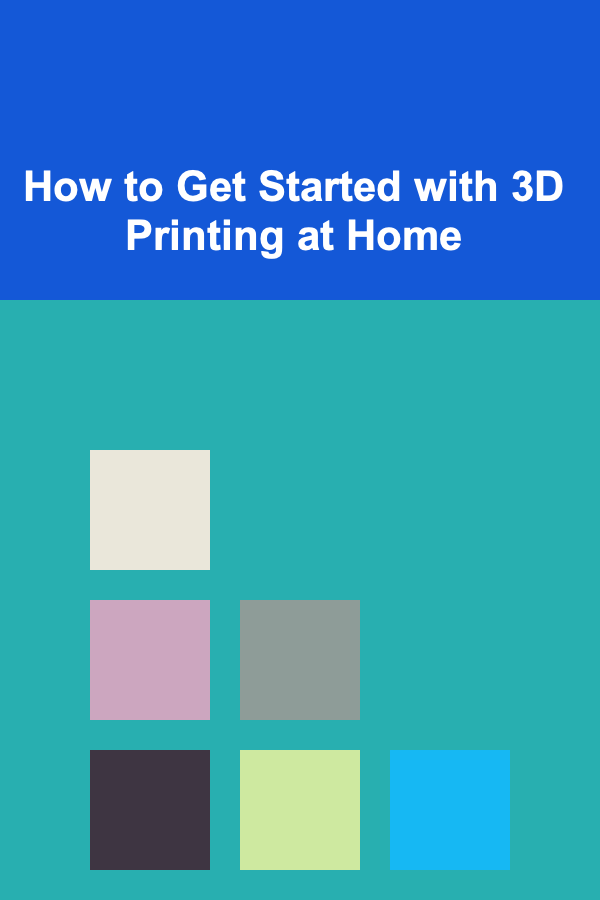
How to Get Started with 3D Printing at Home
ebook include PDF & Audio bundle (Micro Guide)
$12.99$9.99
Limited Time Offer! Order within the next:

3D printing, also known as additive manufacturing, is one of the most innovative and exciting technologies of our time. It has rapidly moved from industrial applications to become a hobbyist activity, and more recently, a practical tool for home use. From creating simple toys and household items to developing intricate mechanical parts or even custom-made prosthetics, 3D printing offers limitless possibilities.
In this article, we'll explore the basics of 3D printing, how to get started with 3D printing at home, and offer insights into the tools, software, and materials required to embark on this fascinating journey.
What is 3D Printing?
At its core, 3D printing is a manufacturing process that creates objects layer by layer from a digital file. Unlike traditional methods of production that involve cutting, molding, or drilling, 3D printing builds objects by adding material in successive layers, which results in less waste and the ability to create highly complex structures.
There are various types of 3D printing technologies, but the most common one for home use is Fused Deposition Modeling (FDM) . FDM printers melt plastic filament and extrude it through a heated nozzle onto a build plate, where it solidifies into the desired shape. Other common methods include Stereolithography (SLA) and Selective Laser Sintering (SLS), though these are typically more expensive and less commonly found in home environments.
Why Should You Get Into 3D Printing?
There are many reasons why 3D printing has become such an appealing hobby for individuals. Here are some of the key benefits of getting started:
2.1. Creativity and Customization
3D printing allows you to create highly customized and unique objects. Whether you want to print a replacement part for a broken item, a personalized gift, or an entirely new invention, the possibilities are virtually endless. You can modify designs to your specifications, creating something that fits your needs perfectly.
2.2. Learning and Skill Development
Getting into 3D printing is an excellent opportunity to learn about design, engineering, and manufacturing processes. It can help you understand how objects are structured, how materials behave, and how digital files translate into physical objects. The experience provides a valuable skillset that can be applied in numerous fields, including product design, engineering, and even architecture.
2.3. Cost-Effective Prototyping
For aspiring inventors and designers, 3D printing offers an affordable way to prototype new ideas. Traditional prototyping methods can be costly and time-consuming, but with 3D printing, you can quickly and cheaply print models to test your concepts. This can be especially valuable for small businesses and independent makers who want to bring products to market without the need for large-scale manufacturing.
2.4. Personal Projects
Whether you're building a model, crafting household items, or even making functional tools, 3D printing enables you to create something practical and fun at home. From home décor to mechanical parts, the potential for personal projects is vast.
What Do You Need to Start 3D Printing at Home?
To start 3D printing at home, you need a few basic pieces of equipment, including a 3D printer, the necessary software, and materials. Let's break them down:
3.1. Choosing the Right 3D Printer
The first and most crucial step in getting started with 3D printing is selecting the right printer. There are numerous options on the market, catering to different budgets, experience levels, and use cases. Here are a few things to consider when purchasing a 3D printer:
- Budget: Entry-level 3D printers can cost anywhere between $150 and $500, while mid-range models can range from $500 to $2,000. More advanced printers, like SLA or SLS printers, can cost upwards of $5,000.
- Build Volume: This refers to the maximum size of the object your printer can create. If you're just making small objects, a compact printer with a smaller build volume should suffice. However, if you're working on larger models, you'll need a printer with a bigger build area.
- Print Quality: The resolution of your 3D printer, measured in microns (µm), determines the level of detail and smoothness of your prints. Higher resolution printers offer finer details but might be slower and more expensive.
- Ease of Use: Consider factors like ease of setup, maintenance, and user interface. If you're a beginner, look for printers that offer intuitive software and clear instructions.
- Type of Printer: As mentioned earlier, FDM is the most common and accessible 3D printing method for home use. If you're looking for higher precision, consider an SLA printer, which uses light to cure resin. SLA printers can produce smooth and detailed models, but they require more maintenance and have a steeper learning curve.
Some popular 3D printer brands for home use include:
- Creality (e.g., Ender series)
- Anycubic (e.g., i3 Mega, Photon series)
- Prusa Research (e.g., Prusa i3 MK3)
- Elegoo (e.g., Mars series)
3.2. 3D Printing Filament
The filament is the material that the 3D printer uses to build the object. Filament comes in different types and sizes, each with its unique properties. The most common types of filament for home 3D printing are:
- PLA (Polylactic Acid): PLA is one of the most popular and beginner-friendly materials. It's biodegradable, easy to use, and doesn't require a heated bed, making it ideal for new users.
- ABS (Acrylonitrile Butadiene Styrene): ABS is a more durable and heat-resistant filament but requires a heated bed and more advanced settings to avoid warping.
- PETG (Polyethylene Terephthalate Glycol): PETG is known for being tough, flexible, and resistant to impact. It's a good choice for functional parts or outdoor items.
- TPU (Thermoplastic Polyurethane): TPU is a flexible filament suitable for making items like phone cases or elastic bands.
- Resin: If you are using an SLA printer, you will need resin. Resin comes in various types, including standard, tough, and flexible resins, which each have different mechanical properties.
The filament comes in spools, usually in 1kg or 500g sizes, and is available in various diameters (1.75mm and 3mm are the most common). When buying filament, make sure to check the compatibility with your printer.
3.3. 3D Modeling Software
Before you can print an object, you need a 3D model to work with. This is where 3D modeling software comes in. There are many different types of software, ranging from beginner-friendly to professional-grade. Here are a few options:
- Tinkercad: Tinkercad is a web-based, beginner-friendly software. It's perfect for simple models and teaches the basics of 3D design.
- Fusion 360: This is a more advanced, professional-grade tool. It's free for students and hobbyists, offering features like parametric design, assemblies, and more.
- Blender: Blender is a powerful open-source software for creating 3D models, animations, and simulations. It has a steep learning curve but is highly versatile.
- SketchUp: SketchUp is an intuitive tool for creating 3D models, with both free and paid versions available. It's ideal for architectural models.
- SolidWorks: SolidWorks is a professional CAD software often used by engineers and product designers. It's robust but comes with a hefty price tag.
Most 3D printers come with software that can convert a 3D model into a file format suitable for printing, such as G-code or STL . You'll need to "slice" your model into layers using slicing software like Cura , PrusaSlicer , or Simplify3D.
3.4. Post-Processing Tools
Once you've printed your object, you may need to do some post-processing to clean it up. Depending on the material and printer, this can include removing support structures, sanding, painting, or curing resin prints under UV light. For resin prints, a UV curing station is often used to solidify the print fully.
The Printing Process: Step by Step
Step 1: Design or Download a 3D Model
You can either design your own 3D model using one of the design tools mentioned earlier or download pre-made models from websites like Thingiverse , MyMiniFactory , or Pinshape.
Step 2: Slice the Model
Using slicing software, you convert your 3D model into instructions that the printer can understand. This is where you'll set print settings like layer height, print speed, and infill percentage.
Step 3: Load the Model and Filament into the Printer
Once you've sliced your model, load the G-code onto your printer (usually via SD card or USB). Then, load the filament into the printer, ensuring it's properly fed into the extruder.
Step 4: Printing the Model
After you've configured your settings, hit print, and watch the printer create your object layer by layer. This can take anywhere from a few hours to over a day, depending on the size and complexity of the model.
Step 5: Post-Processing
Once the print is complete, remove it from the build plate and carefully clean up any support structures or excess material. If you used resin, make sure to cure the print under UV light to finalize the process.
Common Challenges and How to Overcome Them
Like any hobby, 3D printing comes with its own set of challenges. However, most of these can be overcome with patience, practice, and troubleshooting:
5.1. Warping
Warping occurs when the edges of the print curl upwards due to temperature fluctuations. To prevent warping, make sure the print bed is level, and consider using a heated bed or an adhesive like glue stick or hairspray.
5.2. Print Failures
Print failures are common, especially with newer users. Problems like misalignment, clogging, or poor adhesion can arise. Start with smaller prints and experiment with different settings until you find the optimal configuration for your printer.
5.3. Material Issues
Certain filaments, especially ABS, can be tricky to work with because they require a heated bed or specific temperature conditions. Always check the filament manufacturer's guidelines for optimal settings.
Conclusion
Getting started with 3D printing at home can be a rewarding experience. With the right printer, materials, and software, you can create virtually anything you can imagine, from functional items to creative masterpieces. It's a fun, educational, and practical hobby that can open up new opportunities for makers, designers, and inventors.
Whether you're using 3D printing to create custom objects, develop prototypes, or simply explore your creative side, the possibilities are vast and exciting. With a bit of patience and practice, anyone can become a skilled 3D printing enthusiast and unlock the full potential of this transformative technology.

How to Create a Digital Art Portfolio: An Actionable Guide
Read More
How to Create a Professional and Comfortable Living Space for Tenants
Read More
How to Make Money Online as a Musician: 10 Actionable Ideas
Read More
How to Design Custom Journals with Unique Prompts for POD
Read More
How to Buy and Sell Crypto Safely
Read More
Mastering Email Marketing Automation: A Comprehensive Guide
Read MoreOther Products

How to Create a Digital Art Portfolio: An Actionable Guide
Read More
How to Create a Professional and Comfortable Living Space for Tenants
Read More
How to Make Money Online as a Musician: 10 Actionable Ideas
Read More
How to Design Custom Journals with Unique Prompts for POD
Read More
How to Buy and Sell Crypto Safely
Read More